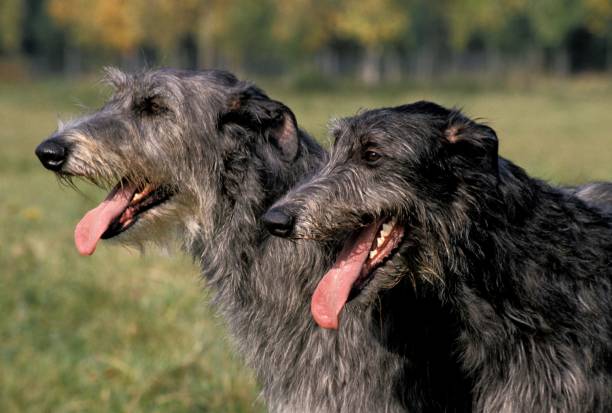Scottish Deerhound

Breed History:
The Scottish Deerhound, often called the "Royal Dog of Scotland," is an ancient breed that dates back to the early Middle Ages. Originally bred to hunt large game such as deer and stags in the rugged Highlands of Scotland, the breed’s history is intertwined with the Scottish nobility. It was prized for its stamina, speed, and ability to chase and bring down large, fast-moving prey.
The Scottish Deerhound is thought to be a descendant of the now-extinct Scottish Greyhound, and its lineage can be traced back over 500 years. Historically, it was used by Scottish clans for hunting, and it became a symbol of strength, nobility, and agility.
Known for its noble demeanour and regal appearance, the Scottish Deerhound remains a rare breed today. Though its hunting days are largely behind it, the Deerhound continues to be a beloved companion dog, admired for its gentle and affectionate nature.
|
Gender |
Height |
Weight |
|
Male |
76–81 cm |
41–55 kg |
|
Female |
71–76 cm |
34–46 kg |
Size – Large
Life Expectancy: 8–11 years

Breed Appearance:
The Scottish Deerhound is a large and powerful breed, known for its elegance and grace. Its most striking feature is its tall, slender yet muscular build, designed for running at high speeds. The Deerhound has a long, narrow head, with a distinctive beard and moustache that give it a dignified, aristocratic look.
The breed’s coat is one of its most recognisable features: it is rough and wiry, with a harsh texture that protects it from the harsh weather of the Scottish Highlands. The colour of the coat can vary, including shades of blue, brindle, fawn, red, or grey, often with a lighter undercoat. The long tail and legs help the Deerhound reach great speeds while hunting, and its posture reflects the breed's swift and nimble nature.
Breed Type – Family/Guard:
The Scottish Deerhound is primarily a companion and hunting dog, but it is also known for its calm, affectionate nature. Despite its historical role as a hunter, the breed is gentle and friendly, making it a wonderful family dog. Deerhounds are particularly good with children and are known for their patient and tolerant demeanour.
Although they have a calm disposition at home, they retain a strong prey drive due to their hunting origins. This means they can be reserved or distant around unfamiliar animals or people, especially if they have not been socialised properly.
The Deerhound is a loyal and affectionate breed, forming deep bonds with its family members. It does well in homes with plenty of space and enjoys both relaxing and being part of outdoor activities with its owners.

Training:
Training the Scottish Deerhound can be a challenge for first-time dog owners due to its independent and sometimes aloof nature. While the Deerhound is intelligent, it is not always eager to please, and its independent streak can make training slow or inconsistent.
Positive reinforcement methods, such as treats and praise, work best for this breed. Harsh training methods should be avoided, as the Deerhound is sensitive and may become stubborn if handled too forcefully. Early socialisation is essential to help the Deerhound become comfortable around other animals and people, as its hunting instinct may cause it to be wary of unfamiliar situations.
Deerhounds are generally more responsive to training when it is fun and rewarding. They tend to respond well to a gentle yet consistent approach.
Health & Care:
The Scottish Deerhound is a generally healthy breed, but it is prone to certain health issues. Due to its large size, it is particularly vulnerable to conditions related to joint health, including hip and elbow dysplasia. Other common health problems include:
-
Dilated cardiomyopathy (heart disease)
-
Hypothyroidism
-
Bloat (gastric torsion)
-
Cancers, particularly osteosarcoma (bone cancer)
The average lifespan of a Scottish Deerhound is shorter than many other breeds, typically around 8–11 years, due in part to the breed's size and susceptibility to health problems. Regular veterinary visits, a healthy diet, and a controlled exercise routine are crucial for ensuring the dog’s well-being.
Due to its rough coat, the Deerhound requires regular grooming, but the breed’s shedding is relatively minimal. It is important to keep up with routine care such as nail trimming, ear cleaning, and brushing to maintain the health of the coat.

Living Conditions:
The Scottish Deerhound is best suited for homes with plenty of space, as it is a large and active breed. While it can adapt to apartment living, it thrives in environments where it has access to a secure yard or open areas to run. The Deerhound enjoys stretching its legs and needs daily exercise to stay healthy and happy.
This breed does well in homes with active families and enjoys being included in outdoor activities such as hiking or running. Despite its size, the Deerhound is generally calm and gentle indoors and will be content lounging around the house after a good run. However, its prey drive should be taken into consideration, as it may chase after small animals.
Because of its size and energy levels, the Deerhound is not ideal for homes where it will be left alone for extended periods. It thrives in homes where it can be an active and engaged member of the family.
Exercise:
The Scottish Deerhound is a highly athletic breed that needs regular, moderate exercise to maintain its physical and mental health. Though it is not as high-energy as some breeds, it requires consistent physical activity to stay fit. This can include long walks, runs, or playtime in a secure yard. It also enjoys participating in activities like agility training and scent work.
Due to its strong hunting instincts, the Deerhound requires an enclosed area to run off-leash, as it may chase after smaller animals if given the opportunity. It is not an ideal breed for dog parks unless under strict supervision.
While the Deerhound is capable of sprinting at high speeds, it does not require excessive exercise; a few daily sessions of moderate activity will help keep it in shape.
Grooming:
The Scottish Deerhound has a wiry, rough coat that requires regular grooming. Brushing the coat 1–2 times a week is recommended to keep it free from mats and tangles. The breed sheds minimally, but regular grooming helps maintain the coat’s texture and appearance.
Bathing should be done as needed, typically every 6–8 weeks or when the dog becomes dirty after outdoor activities. A mild dog shampoo should be used to preserve the coat’s natural oils. Deerhounds also need regular nail trimming, ear cleaning, and dental care.
Since the Deerhound is prone to joint issues due to its size, ensuring it maintains a healthy weight is important to prevent additional strain on the joints.

Advantages:
-
Calm and gentle, making it an excellent companion for families
-
Great with children, especially when socialised early
-
Independent yet loyal and affectionate
-
Low shedding and minimal grooming requirements compared to other breeds
-
Agile and fast, with an instinct for running
-
Good in both active and relaxed environments, as long as exercise needs are met
-
Noble and dignified appearance, with a regal presence
Disadvantages:
-
Independent nature can make training challenging for inexperienced owners
-
Shorter lifespan compared to other breeds
-
High prey drive, which may make it unsuitable for homes with smaller pets
-
Requires large spaces or secure yards to run in
-
Susceptible to certain health issues, including joint problems and heart disease
-
Can be aloof or reserved around strangers if not properly socialized

